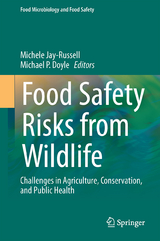Food Safety Risks from Wildlife
Springer International Publishing (Verlag)
978-3-319-24440-2 (ISBN)
Foodborne illnesses caused by zoonotic pathogens associated with wildlife hosts are an emerging microbial food safety concern. Transmission of foodborne pathogens can occur through ingestion, or improper handling, of contaminated game meat. Wild and feral animals have also been investigated as potential sources of Campylobacter, Escherichia coli O157:H7 and other enteric pathogens following foodborne disease outbreaks linked to fresh fruits and vegetables (e.g., baby spinach in California, shelled-peas in Alaska, strawberries in Oregon). This book explores the range of bacterial, parasitic, and viral pathogens that have been described in wildlife populations in the United States, Europe and other parts of the world. It also addresses important challenges and solutions to balance agriculture, conservation, and public health goals. The book provides unique information on approaches in risk communication, co-management, and One Health in a wildlife-food safety context. The first five chapters review research on the detection, epidemiology and ecology of foodborne pathogens in wildlife populations including the influence of wildlife-livestock-human interactions. The second half of the book addresses current guidelines to mitigate microbial food safety risks from wildlife hosts and new regulations proposed by the U.S. Food and Drug Administration in the Food Safety Modernization Act Produce Safety Rule. Chapters are written by an array of internationally reco
gnized authors, and will be of interest to agriculture safety experts, ecologists, environmental health specialists, food safety professionals, microbiologists, public health practitioners, veterinarians, wildlife biologists, and others in academia, government, industry, and students in these disciplines.Preface.- 1. Overview: Foodborne Pathogens in Wildlife Populations.- 2. Emerging Viral Zoonoses from Wildlife Associated with Animal-Based Food Systems: Risks and Opportunities.- 3. A European Perspective on the Transmission of Food-Borne Pathogens at the Wildlife-Livestock-Human Interface.- 4. Microbiological Hazards of Wild Birds and Free-Range Chickens.- 5. Molecular Tools for Monitoring and Source-Tracking Salmonella in Wildlife and the Environment.- 6. Reducing the Risk of Foodborne Transmission of Nipah Virus.- 7. A Survey Of How Growers, Shippers, And Handlers Address Food Safety Risks From Wildlife In Leafy Greens.- 8. Keeping Wildlife Out of Your Food: Mitigation and Control Strategies to Reduce the Transmission Risk of Food-Borne Pathogens.- 9. Co-management: Balancing Food Safety, the Environment and the Bottom Line.- 10. Recommendations to Regulations: Managing Wildlife and Produce Safety on the Farm.- 11. A One Health Approach to Wildlife and Food Safety.- Index.
| Erscheinungsdatum | 03.12.2015 |
|---|---|
| Reihe/Serie | Food Microbiology and Food Safety | Research and Development |
| Zusatzinfo | XII, 254 p. 21 illus. |
| Verlagsort | Cham |
| Sprache | englisch |
| Maße | 155 x 235 mm |
| Themenwelt | Naturwissenschaften ► Biologie ► Mikrobiologie / Immunologie |
| Technik | |
| Schlagworte | Chemistry and Materials Science • Environmental Health • Foodborne pathogens • Food Safety • food science • Fresh produce • Game meat • wildlife • Zoonoses |
| ISBN-10 | 3-319-24440-X / 331924440X |
| ISBN-13 | 978-3-319-24440-2 / 9783319244402 |
| Zustand | Neuware |
| Haben Sie eine Frage zum Produkt? |
aus dem Bereich




